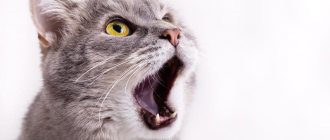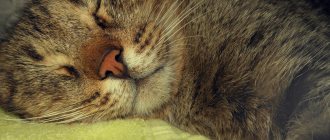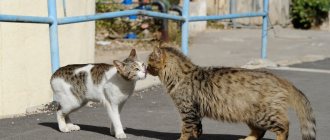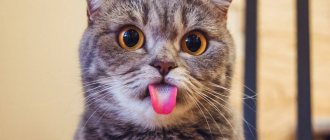The cat's tongue is a multifunctional, natural organ, the properties of which greatly influence the cat's life. Discrimination of tastes, thermoregulation, toilet/hygienic procedures are its main functions. At the same time, aimless display of it in cats, unlike dogs, is not accepted; this is their internal “wealth”. The material provides brief answers to the question “why and why do all cats have a rough tongue?”
My tongue is my wealth. I'll show you as much as I want.
Rough tongue
We all feel that same roughness when a cat licks our hands. This is explained by the fact that cats have a large number of papillae on their tongue. There are 4 types of them:
- Filiform (cone-shaped) - these are the papillae that are responsible for the brush effect. This is because they grow in the opposite direction to the sky. This helps the animal take care of its fur. In addition, your pet has the largest number of them, since this form of papillae is the most common. They occupy the anterior half of the tongue.
- Leaf-shaped are the largest papillae, which are located on both sides of the tongue.
- Mushroom - as the name suggests, they are shaped like mushrooms. They are located at the edges of the cat's tongue.
- Grooved - these papillae are located on the back of the tongue. By their arrangement they form a V-row. In front of them are the fungiform papillae.
Calcivirosis
Another source of red spots on the tongue can be the viral disease calcivirosis; it has more than 40 varieties, each of which manifests itself in its own way. It is distributed exclusively among felines and is not transmitted to dogs or humans.
Accurate diagnosis of calcivirosis is possible only on the basis of laboratory examination of blood and tissues, but, as practice shows, this disease cannot always be determined.
Popular Why do wounds appear on a cat's tail?
In some cases, the disease occurs in a latent form, against the background of other diseases. Weakened, sedentary cats with signs of immunodeficiency are more susceptible to infection.
Vaccinating an animal against calcivirus can reduce, but not eliminate, the risk of the disease, since vaccination does not cover the entire number of virus varieties.
Functions
The functions of a cat's tongue are quite obvious. With its help, the animal takes care of itself by licking its fur. It also removes food debris from the mouth and face. We have all seen how a cat washes itself: after wetting its paw, it runs it over its face. These manipulations help cleanse it.
In addition, with the help of its tongue, the cat tastes the food offered to it and determines its temperature. If these criteria do not suit her, she will not eat the food you give her.
The peculiarity of the structure of the papillae of a cat's tongue provides it with the ability to drink water and liquid food. Running its tongue along the surface of the water, the cat lifts it, creating a trickle, which it drinks.
Let's watch the cat
A cat is a very neat animal; it always keeps its fur in order. Observe her behavior. Before curling up into a cozy ball, a cat will certainly groom its fur, wash its face with its paw and its tongue plays the most important role in this matter.
Natural comb for cats
Its entire surface is covered with small points that resemble hooks. They are directed towards the pharynx, covered with keratin (our nails are made of this substance). That is why, by licking you, showing its love and tenderness, a cat can cause minor pain, discomfort, small hooks scratch like sandpaper. This quality of a cat's tongue can be compared to the action of a comb. Just as a person combs and smoothes his hair, a cat performs similar actions with its tongue.
Cats are given the opportunity to carefully care for their fur, which cannot be said about dogs; they do not have such sharp hooks on their tongues, they are not able to untangle tufts of fur. It is worth noting that although cats have such an effective grooming tool, they do not always use it. Very often, lazy cats, overweight cats, sick animals, or simply spoiled, self-satisfied specimens do not bother to lick all areas of the body. They often leave this work to their owners.
If you have already taken on the responsibility of a cat caretaker, then carefully inspect the fur to avoid the formation of stray lumps (tangles).
Swallowing objects
The reason why cats have a rough tongue is their tendency to swallow various inedible objects. Everyone noticed the animal’s love for Christmas tree tinsel, laces and other hanging objects.
This all happens because, due to the structure of the tongue, a cat, having taken an object into its mouth, can no longer get rid of it. And the only option they have is to swallow the object. The papillae of the tongue simply push the object deep into the digestive tract.
This situation is not always harmless. For example, cats love to swallow needles. The animal is interested in the thread on the needle. During the game it turns out that it is not separated from the tongue. It becomes simply impossible to remove the thread. Due to the direction of the papillae and swallowing movements, the thread gradually moves deeper into the pharynx, carrying the needle with it. And finally the cat can only swallow them. The needle penetrates the digestive tract. In most cases, everything works out well, because the needle is swallowed with the blunt end and also goes all the way through. However, this does not always happen; there are also cases of injury.
Diagnosis and treatment
Although pigmentation in most cases is not dangerous, you should take your pet to the veterinarian. He will establish the exact cause using a visual examination, laboratory tests, and examination of the mucous membrane for bacterial contamination. Treatment:
- With acne, it is enough to get rid of the cause that caused the rash. The animal's condition will return to normal.
- Lentigo is a congenital manifestation, so no treatment is required.
- For fungal diseases, antiseptics are prescribed for rinsing (Stomadex, solutions of Chlorhexidine, hydrogen peroxide, furatsilin) and antifungal agents (potassium iodide, Clotrimazole, Amphotericin).
- Mycoplasmosis - therapy consists of restoring the immune system, giving antibiotics (Ofloxacin, Azithromycin), treating the oral cavity (Ribotan, Cycloferon). Probiotics and Feliferon injections can be prescribed.
- Oncological diseases often remain untreated.
For any reason, it is mandatory to include vitamin-mineral complexes in the diet.
Feel
Why do cats have rough tongues? Because it is dotted with papillae. But this not only gives the animal additional positive characteristics. It also increases the sensitivity of the tongue. If a cat injures its tongue for any reason, then this pain will exceed the sensations that the cat would experience if another part of the body was injured. The tongue turns out to be much more sensitive than the paw, tail or ear.
By the way, due to the fact that the cat has a rough tongue, its teeth always remain clean and sharp.
It’s also no secret that the tongue is a storehouse of taste buds. The receptors on the cat's tongue are also responsible for distinguishing taste, but in a slightly different way. Firstly, a cat has much fewer receptors themselves. If a person has about 9000 of them, then an animal has only 473. Secondly, despite the smaller number, they distinguish tastes more sharply and strongly.
In addition, due to the peculiarities of the tongue, cats provide themselves with the function of thermoregulation. You've probably often noticed that during hot weather, your pet sticks its unit out. She does this to evaporate excess moisture from the body, since the cat does not have sweat glands that provide this. This way the pet lowers its body temperature.
What causes the problem?
Pulmonary edema
A cat with a white tongue and black dots on it may indicate problems with the respiratory system. Of particular danger to a pet is pulmonary edema, in which there is a high risk of death without timely provision of veterinary care. Before prescribing treatment, the pet undergoes diagnostic procedures and determines the degree of the disorder. Therapy in most cases is performed in a hospital setting, where specialists can monitor the cat’s health.
How does pneumothorax occur?
This pathology is manifested by shortness of breath in the animal, which can quickly turn into suffocation. The disease is characterized by the accumulation of air in the sternum, while pneumothorax often occurs together with hydrothorax, with fluid filling in the chest cavity. If there is a deviation, the cat’s internal organ is not able to fill with air normally. Sometimes an animal experiences complete failure of one lung. When the cat gets sick, the tongue becomes very blue and the risk of the pet dying from suffocation increases, which occurs due to the continuous flow of liquid and air into the respiratory tract.
Heart defects
When blue spots appear on your cat's tongue or the palate and inside of the mouth turn pale, it is worth taking the animal to the veterinarian. Such symptoms are a signal of the progression of congenital heart defects. With such disorders, the clinical picture is observed in a kitten up to 2 months of age. Among the most common deviations are the following:
- atrial septal defect;
- combined heart defect “tetralogy of Fallot”;
- impaired function of the interventricular septum.
What is asthma associated with?
The symptom often accompanies animals suffering from such a disease of the respiratory system. A blue tongue in kittens and adult felines can be a consequence of an asthmatic attack. The disease occurs in pets of all ages and occurs with coughing and difficulty breathing. When asthma is advanced, the pet develops cyanosis and respiratory failure. Cat owners can recognize the disease not only by its blue tongue. When taking x-rays, pathological changes in the lungs are observed, and eosinophils are detected in excessive quantities in the blood. The deviation is immune in nature, so it is difficult to completely eliminate it, and sometimes even impossible.
Diaphragmatic hernia: causes of appearance
A cat's tongue is black or has a bluish tint due to a fall from a great height, which leads to rupture of the diaphragm and prolapse of internal organs into the chest. In this case, air enters the respiratory tract incorrectly, causing oxygen deficiency and blue mucous membranes of the tongue. The pathology can only be eliminated surgically, in which the displaced internal organs are returned to their original place, and the diaphragm is sutured
It is important to understand that such assistance is provided only with early diagnosis of diaphragmatic hernia









